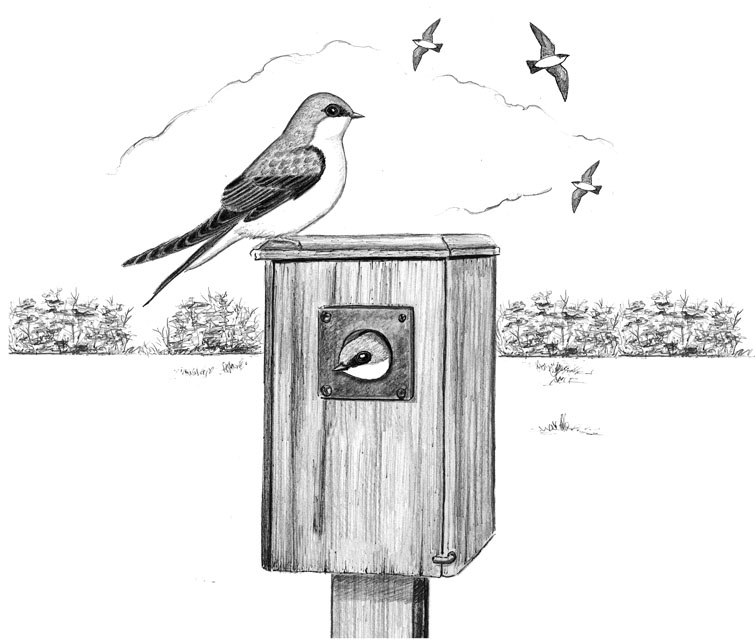
Dear Bird Folks,
For well over a month I’ve had a pair of Tree Swallows in one of my birdhouses. Oddly, the birds don’t do anything except sit and look out of the entrance hole all day. Do you think they actually have a nest or are they simply using my birdhouse for a hangout?
– Warren, Plymouth, MA
They have a nest, Warren,
The idea of relaxing and watching the world go by is okay for retirees, folks on vacation and people stuck in line at the post office, but not for birds in the spring. Birds only have a brief opportunity to reproduce; so merely hanging out isn’t a viable option. Why then, you wonder, are your birds just looking out of the hole and not sitting on eggs? What the swallows are doing is the human equivalent of putting a jacket on an empty table in a crowded coffee shop. I’ll explain that…eventually.
Our most popular birdhouses are ones designed for bluebirds. Next in popularity are boxes for wrens, chickadees and owls. Way down on this list, even after bats (which some people continue to think of as being birds, no matter how many times I correct them), are Tree Swallow boxes, and I don’t get it. I love Tree Swallows. They are beautiful birds, they eat tons of insects and cause no problems for anybody (except to occasionally fight with the sainted bluebirds). And while they don’t come to feeders like chickadees do, or sing loudly like wrens and aren’t trending like owls are right now, they still are appealing backyard birds…if you have the right backyard.
In spite of their name, Tree Swallows aren’t overly fond of trees (except to use old tree holes to nest in). Because they forage on the wing, swallows prefer wide-open spaces. Farms, fields and salt marshes are good places to look for these acrobatic birds. I live in a rather congested neighborhood, but right around the corner from me is a large marsh. As a result, we annually get a pair of Tree Swallows in one of our boxes. Each spring, near the end of March, the pair arrives from the south. Seeing them immediately brings a huge smile to my face, plus a little concern. Like all swallows, Tree Swallows are predominately insect-eaters and late March seems way too premature for them to be this far north. It’s just too cold and bug-less. (At least it’s too cold for me, but I’m okay with no bugs.) How do the swallows survive? Tree Swallows are one of the few birds that can actually digest the wax coating on the Cape’s abundant supply of bayberries. The bayberries not only provide them with food when insects aren’t available, but the aromatic berries also give the birds lovely-smelling breath (maybe.).
A good question to ask is: Why don’t the Tree Swallows simply wait for things to warm up a little before they return? After all, that’s what all of the other swallow species do. It’s about the competition. Historically, Tree Swallows nest in old woodpecker holes. While there isn’t a shortage of woodpecker holes (the forests are filled with them), the holes are scarce near open fields, which is the swallow’s required habitat. Often there are more returning birds than there are spaces available (like Cape Cod on Fourth of July weekend). To keep from getting shutout, the swallows arrive as early as possible, quickly claim a nest site, and then try to survive the weather the best they can. It’s not easy.
The first thing a couple does upon returning is add a bit of nesting material to their chosen cavity. This lets the other birds know the site is taken. (It’s the “jacket on an empty table in a coffee shop” we mentioned earlier.) Over the coming weeks the swallows will come and go, only making sporadic visits to the site, just to make sure no squatters have moved in. By mid-May, when things have warmed up enough, the female will finally complete her nest and lay five white eggs. One of the major components of a Tree Swallow’s nest is feathers, lots of feathers.
The reason for the feathers isn’t totally understood, but one theory is that they help to keep the eggs warm when the female is off the nest. This theory makes sense because she is off the nest a lot. When the female leaves the nest in order to either forage for food or run her daily errands, the male immediately moves into the box, but he doesn’t try to keep the eggs warm (that’s the feathers’ job). Instead, he looks out of the hole with a mean scowl on his face. Why? He wants to make sure no usurping swallows move in. This seems to work, as I’ve never seen another bird challenge his scary face. (Forget the jacket; the next time I go into a crowded coffee shop, I’m putting a Tree Swallow on an empty table.)
One indication that the eggs have hatched is when we see an adult leave the box while carrying a “white package.” What’s in the package? This pretty parcel contains fresh baby bird poop. It sounds gross, but it’s a signal that the kids have hatched and are eatin’ good in the neighborhood.
The swallows in your box most certainly have a nest, Warren. By the time you read my response, the adults will have stopped guarding the entrance and will be busy delivering insects to their babies. This is when having nest boxes becomes the most rewarding. It’s fun to sit outside and watch the parents swoop in with mouthfuls of food. Just don’t get too close to the adults when they’re carrying out the packages of poop. In this case, their breath most definitely won’t smell like bayberries.